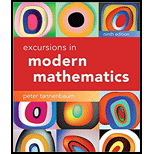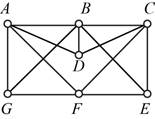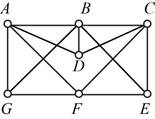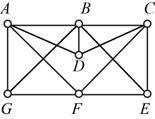
For the graph shown in Fig. 6-19,
a. find three different Hamilton circuits.
b. find a Hamilton path that starts at A and ends at B.
c. find a Hamilton path that starts at D and ends at F.

(a)
To find:
Three Hamilton circuits for given graph.
Answer to Problem 1E
Solution:
The Hamilton circuit are
Explanation of Solution
Given:
The given figure is,

Approach:
A Hamilton circuit is the circuit that starts and ends at the same vertex and includes every other vertex of the graph only once.
Calculation:
Let’s start with vertex A the options to go forward are vertices B, D, F, and G, go to vertex B. From vertex B the options to move further are C, D, E, and G, go to vertex D. From vertex D the option to go forward is vertex C. From vertex C the option to move forward to is E. From vertex E the option to move forward to is F. From vertex F the option to move forward to is G. From vertex G the option to move forward to is A.
The Hamilton circuit is
Let’s start with vertex A the options to go forward are vertices B, D, F, and G, go forward with vertex G. From vertex G the options to move further are B and F, go forward with vertex B. From vertex B the options to go forward are vertices C, D, and E, go to vertex D. From vertex D the option to move forward to is C. From vertex C the option to move forward to is E. From vertex E the option to move forward to is F. From vertex F the option to move forward to is A.
The Hamilton circuit is
Let’s start with vertex A the options to go forward are vertices B, D, F, and G, go forward with vertex D. From vertex D the options to move further are B and C, go forward with vertex B. From vertex B the options to go forward are vertex C and E, go to vertex E. From vertex E the option to move forward to is C. From vertex C the option to move forward to is F. From vertex F the option to move forward to is G. From vertex G the option to move forward to is A.
The Hamilton circuit is
Conclusion:
Thus, the Hamilton circuits are
(b)
To find:
A Hamilton path that starts at A and ends at B.
Answer to Problem 1E
Solution:
A Hamilton path that starts at A and ends at B is
Explanation of Solution
Given:
The given figure is,

Approach:
A Hamilton path is the path that includes every other vertex of the graph only once.
Calculation:
Let’s start with vertex A the options to go forward are vertices B, D, F, and G, go forward with vertex G. From vertex G the options to move further are B and F, go forward with vertex F. From vertex F the options to go forward are vertex C, E, and G, go to vertex E. From vertex E the option to move forward to are B and C, go to vertex C. From vertex C the option to move forward to are B and D, go to vertex D. From vertex D the option to move forward to is B.
The Hamilton path is
Conclusion:
Thus, a Hamilton path that starts at A and ends at B is
(c)
To find:
A Hamilton path that starts at D and ends at F.
Answer to Problem 1E
Solution:
A Hamilton path that starts at D and ends at F is
Explanation of Solution
Given:
The given figure is,

Approach:
A Hamilton path is the path that includes every other vertex of the graph only once.
Calculation:
Let’s start with vertex D the options to go forward are vertices A, B, C, go forward with vertex C. From vertex C the options to move further are B, E and F, go forward with vertex E. From vertex E the options to go forward are vertex B and F, go to vertex B. From vertex B the option to move forward to are A and G, go to vertex G. From vertex G the option to move forward to are A and F, go to vertex A. From vertex A the option to move forward to is F.
The Hamilton path is
Conclusion:
Thus, a Hamilton path that starts at D and ends at F is
Want to see more full solutions like this?
Chapter 6 Solutions
Excursions in Modern Mathematics, Books a la carte edition (9th Edition)
Additional Math Textbook Solutions
A First Course in Probability (10th Edition)
University Calculus
Elementary Statistics: A Step By Step Approach
Algebra and Trigonometry (6th Edition)
Finite Mathematics for Business, Economics, Life Sciences and Social Sciences
- 9. (a) Use pseudocode to describe an algo- rithm for determining the value of a game tree when both players follow a minmax strategy. (b) Suppose that T₁ and T2 are spanning trees of a simple graph G. Moreover, suppose that ₁ is an edge in T₁ that is not in T2. Show that there is an edge 2 in T2 that is not in T₁ such that T₁ remains a spanning tree if ₁ is removed from it and 2 is added to it, and T2 remains a spanning tree if 2 is removed from it and e₁ is added to it. (c) Show that a degree-constrained spanning tree of a simple graph in which each vertex has degree not exceeding 2 2 consists of a single Hamiltonian path in the graph.arrow_forwardChatgpt give wrong answer No chatgpt pls will upvotearrow_forward@when ever one Point sets in x are closed a collection of functions which separates Points from closed set will separates Point. 18 (prod) is product topological space then VaeA (xx, Tx) is homeomorphic to sul space of the Product space (Txa, prod). KeA © The Bin Projection map B: Tx XP is continuous and open but heed hot to be closed. A collection (SEA) of continuos function oha topolgical Space X se partes Points from closed sets inx iff the set (v) for KEA and Vopen set in Xx from a base for top on x.arrow_forward
- Simply:(p/(x-a))-(p/(x+a))arrow_forwardMake M the subject: P=2R(M/√M-R)arrow_forwardExercice 2: Soit & l'ensemble des nombres réels. Partie A Soit g la fonction définie et dérivable sur R telle que, pour tout réel x. g(x) = - 2x ^ 3 + x ^ 2 - 1 1. a) Étudier les variations de la fonction g b) Déterminer les limites de la fonction gen -oo et en +00. 2. Démontrer que l'équation g(x) = 0 admet une unique solution dans R, notée a, et que a appartient à | - 1 ;0|. 3. En déduire le signe de g sur R. Partie B Soit ƒ la fonction définie et dérivable sur R telle que, pour tout réel s. f(x) = (1 + x + x ^ 2 + x ^ 3) * e ^ (- 2x + 1) On note f la fonction dérivée de la fonction ƒ sur R. 1. Démontrer que lim x -> ∞ f(x) = - ∞ 2. a) Démontrer que, pour tout x > 1 1 < x < x ^ 2 < x ^ 3 b) En déduire que, pour x > 1 0 < f(x) < 4x ^ 3 * e ^ (- 2x + 1) c) On admet que, pour tout entier naturel n. lim x -> ∞ x ^ n * e ^ (- x) = 0 Vérifier que, pour tout réel x, 4x ^ 3 * e ^ (- 2x + 1) = e/2 * (2x) ^ 3 * e ^ (-2x) puis montrer que: lim x -> ∞ 4x ^ 3 * e…arrow_forward
 Linear Algebra: A Modern IntroductionAlgebraISBN:9781285463247Author:David PoolePublisher:Cengage Learning
Linear Algebra: A Modern IntroductionAlgebraISBN:9781285463247Author:David PoolePublisher:Cengage Learning Algebra: Structure And Method, Book 1AlgebraISBN:9780395977224Author:Richard G. Brown, Mary P. Dolciani, Robert H. Sorgenfrey, William L. ColePublisher:McDougal Littell
Algebra: Structure And Method, Book 1AlgebraISBN:9780395977224Author:Richard G. Brown, Mary P. Dolciani, Robert H. Sorgenfrey, William L. ColePublisher:McDougal Littell

